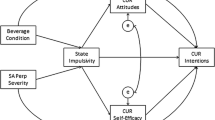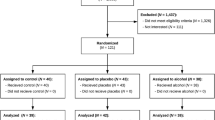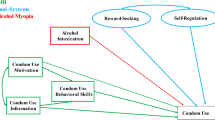Abstract
The present research aimed to examine the relationships among gender, condom-related protective behavior strategies (PBS), and condom use during alcohol-related sexual behavior. Heavy drinking, sexually active U.S. undergraduate college students from a large northwest university (N = 454; 61.7% female) completed a web-survey that included measures of drinking, sexual behavior, and condom-related PBS. MANOVA findings suggested that males were more likely to use condom-related PBS than females. Negative binomial regression results suggested that use of condom-related PBS by both genders was positively associated with condom use during alcohol-related sexual behavior, but especially for women. These results suggest that condom-related PBS may be useful to incorporate in interventions targeting alcohol-related sexual behavior among heavy drinking college students.

Similar content being viewed by others
References
Albarracín, D., McNatt, P. S., Klein, C., Ho, R., Mitchell, A., & Kumkale, G. T. (2003). Persuasive communications to change actions: an analysis of behavioral and cognitive impact in HIV prevention. Health Psychology, 22, 166–177.
Albarracín, D., Gillette, J. C., Earl, A. N., Glasman, L. R., Durantini, M. R., & Ho, M. H. (2005). A test of major assumptions about behavior change: a comprehensive look at the effects of passive and active HIV-prevention interventions since the beginning of the epidemic. Psychological Bulletin, 131, 856–897.
American College Health Association. (2008). American college health association—national college health assessment spring 2007 reference group data report (abridged). Journal of American College Health, 56, 469–479.
Atkins, D. C., & Gallop, R. J. (2007). Rethinking how family researchers model infrequent outcomes: a tutorial on count regression and zero-inflated models. Journal of Family Psychology, 21, 726–735.
Bolger, N., Davis, A., & Rafaeli, E. (2003). Diary methods: capturing life as it is lived. Annual Review of Psychology, 54, 579–616.
Brackett, K. P. (2004). College students’ condom purchase strategies. The Social Science Journal, 41, 459–464.
Bryan, A., Fisher, J. D., & Fisher, W. A. (2002). Tests of the mediational role of preparatory safer sexual behavior in the context of theory of planned behavior. Health Psychology, 21, 71–80.
Carter, J. A., McNair, L. D., Corbin, W. R., & Williams, M. (1999). Gender differences related to heterosexual condom use: the influence of negotiation styles. Journal of Sex and Marital Therapy, 25, 217–225.
Centers for Disease Control and Prevention, National Center for HIV/AIDS, Viral Hepatitis, STD, and TB Prevention (2008a). 2006 Disease Profile, 2008, pp. 1–65. Atlanta, GA: U.S. Department of Health and Human Services.
Centers for Disease Control and Prevention. (2008a). Sexually transmitted disease surveillance, 2007. Atlanta, GA: US Department of Health and Human Services.
Chesson, H. W., Blandford, J. M., Gift, T. L., Tao, G., & Irwin, K. L. (2004). The estimated direct medical cost of sexually transmitted disease among American youth, 2000. Perspectives on Sexual and Reproductive Health, 36, 11–19.
Cohen, J. (1988). Statistical power analysis for the behavioral sciences. Hillsdale, NJ: Lawrence Erlbaum Associates.
Cohen, J., Cohen, P., West, S. G., & Aiken, L. S. (2003). Applied multiple regression/correlation analysis for the behavioral sciences (3rd ed.). Mahwah, NJ: Lawrence Erlbaum Associates.
Collins, R. L., Parks, G. A., & Marlatt, G. A. (1985). Social determinants of alcohol consumption: the effects of social interaction and model status on the self-administration of alcohol. Journal of Consulting and Clinical Psychology, 53, 189–200.
Cooper, M. L. (2002). Alcohol use and risky sexual behavior among college students and youth: Evaluating the evidence. Journal of Studies on Alcohol, Suppl, 14, 101–117.
Frankel, A., & Curtis, D. A. (2008). What’s in a purse? Maybe a woman’s reputation? Sex Roles, 59, 615–622.
Goldstein, A. L., Barnett, N. P., Pedlow, C. T., & Murphy, J. G. (2007). Drinking in conjunction with sexual experiences among at-risk college student drinkers. Journal of Studies on Alcohol and Drugs, 68, 697–705.
Henshaw, S. K. (1998). Unintended pregnancy in the United States. Family Planning Perspectives, 30, 24–29.
Hingson, R., Heeren, T., Winter, M., & Wechsler, H. (2005). Magnitude of alcohol-related mortality and morbidity among U.S. college students ages 18–24: Changes from 1998 to 2001. Annual Review of Public Health, 26, 259–279.
Kelly, J., & Bazzini, D. G. (2001). Gender, sexual experience, and the sexual double standard: evaluations of female contraceptive behavior. Sex Roles, 45, 785–799.
Kypri, K., & Gallagher, S. J. (2003). Incentives to increase participation in an internet survey of alcohol use: a controlled experiment. Alcohol & Alcoholism, 38, 437–441.
Larimer, M. E., Lee, C. M., Kilmer, J. R., Fabiano, P., Stark, C., Geisner, I. M., et al. (2007). Personalized mailed feedback for college drinking prevention: a randomized clinical trial. Journal of Consulting and Clinical Psychology, 75, 285–293.
Lewis, M. A., Rees, M., Logan, D. E., Kaysen, D. L., & Kilmer, J. R. (2009). Use of drinking protective behavioral strategies in relation to sex-related alcohol negative consequences: The mediating role of alcohol consumption. Manuscript under review.
Martens, M. P., Taylor, K. K., Damann, K. M., Page, J. C., Mowry, E. S., & Cimini, M. D. (2004). Protective behavioral strategies when drinking alcohol and their relationship to negative alcohol-related consequences in college students. Psychology of Addictive Behaviors, 18, 390–393.
Martens, M. P., Ferrier, A. G., Sheehy, M. J., Corbett, K., Anderson, D. A., & Simmons, A. (2005). Development of the protective behavioral strategies survey. Journal of Studies on Alcohol, 66, 698–705.
Martens, M. P., Ferrier, A. G., & Cimini, D. (2007). Do protective behavioral strategies mediate the relationship between drinking motives and alcohol use among college students? Journal of Studies on Alcohol, 68, 106–114.
McCabe, S. E., Boyd, C. J., Couper, M. P., Crawford, S., & D’Arcy, H. (2002). Mode effects for collecting alcohol and other drug use data: web and US mail. Journal of Studies on Alcohol, 63, 755–761.
McCabe, S. E., Hughes, T. L., Bostwick, W., & Boyd, C. J. (2005). Assessment of difference in dimensions of sexual orientation: implications for substance use research in a college-age population. Journal of Studies on Alcohol, 66, 620–629.
Neal, D. J., & Fromme, K. (2007). Event-level covariation of alcohol intoxication and behavioral risks during the first year of college. Journal of Consulting and Clinical Psychology, 75, 294–306.
Noar, S. M. (2008). Behavioral interventions to reduce HIV-related sexual risk behavior: review and synthesis of meta-analytic evidence. AIDS & Behavior, 12, 335–353.
Noar, S. M., Morokoff, P. J., & Harlow, L. L. (2002). Condom negotiation in heterosexually active men and women: development and validation of a condom influence strategy questionnaire. Psychology and Health, 17, 711–735.
Norris, J., Masters, N. T., & Zawacki, T. (2004). Cognitive mediation of women’s sexual decision making: the influence of alcohol, contextual factors, and background variables. Annual Review of Sex Research, 15, 259–296.
O’Malley, P. M., & Johnston, L. D. (2002). Epidemiology of alcohol and other drug use among American college students. Journal of Studies on Alcohol Suppl, 14, 23–39.
Padian, N. S., Shiboski, S. C., & Jewell, N. P. (1991). Female-to-male transmission of human immunodeficiency virus. Journal of the American Medical Association, 266, 1664–1667.
Pealer, L. N., Weiler, R. M., Pigg, R. M., Miller, D., & Dorman, S. M. (2001). The feasibility of a web-based surveillance system to collect risk behavior data from college students. Health Education & Behavior, 28, 547–559.
Read, J. P., Wood, M. D., Davidoff, O. J., McLacken, J., & Campbell, J. F. (2002). Making the transition from high school to college: the role of alcohol-related social influence factors in students’ drinking. Substance Abuse, 23, 53–65.
Sheeran, P., Abraham, C., & Orbell, S. (1999). Psychosocial correlates of heterosexual condom use: a meta-analysis. Psychological Bulletin, 125, 90–132.
Substance Abuse and Mental Health Services Administration. (2007). The NSDUH report: Sexually transmitted diseases and substance use. MD: Rockville.
Tabachnick, B. G., & Fidell, L. S. (2001). Using multivariate statistics (4th ed.). Needham Heights, MA: Allyn & Bacon.
Wasserheit, J. N. (1992). Epidemiologic synergy: Interrelationships between human immunodeficiency virus infection and other sexually transmitted diseases. Sexually Transmitted Diseases, 9, 61–77.
Weinstock, H., Berman, S., & Cates, W., Jr. (2004). Sexually transmitted diseases in American youth: Incidence and prevalence estimates, 2000. Perspectives on Sexual and Reproductive Health, 36, 6–10.
Author information
Authors and Affiliations
Corresponding author
Rights and permissions
About this article
Cite this article
Lewis, M.A., Logan, D.E. & Neighbors, C. Examining the Role of Gender in the Relationship Between Use of Condom-Related Protective Behavioral Strategies when Drinking and Alcohol-Related Sexual Behavior. Sex Roles 61, 727–735 (2009). https://doi.org/10.1007/s11199-009-9661-1
Received:
Accepted:
Published:
Issue Date:
DOI: https://doi.org/10.1007/s11199-009-9661-1




